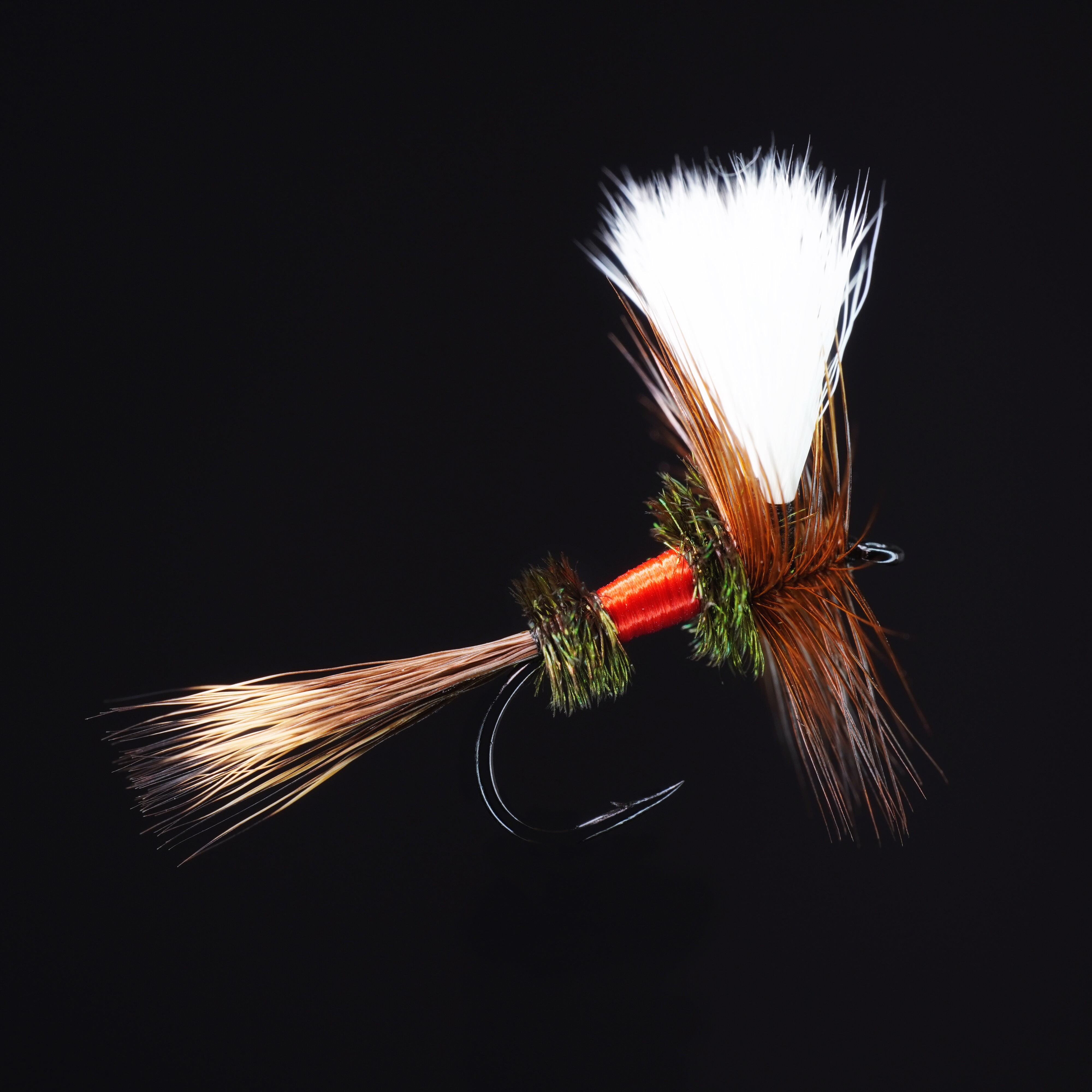Royal Wulff on:
[Wikipedia]
[Google]
[Amazon]
 The Royal Wulff is a popular
The Royal Wulff is a popular
 The Royal Wulff is a popular
The Royal Wulff is a popular artificial fly
An artificial fly or fly lure is a type of fishing lure, usually used in the sport of fly fishing (although they may also be used in other forms of angling). In general, artificial flies are an imitation of aquatic insects that are natural food ...
used for dry fly fishing Dry fly fishing is an angling technique in which the lure is an artificial fly which floats on the surface of the water and does not sink below it. Developed originally for trout fly fishing.
The fish and the dry fly
Fly fishing for trout can b ...
. It is an attractor pattern and a descendant of both the Royal Coachman
The Royal Coachman is an artificial fly that has been tied as a wet fly, dry fly and streamer pattern. Today, the Royal Coachman and its variations are tied mostly as dry flies and fished floating on the water surface. It is a popular and widel ...
fly and the Wulff style of hair wing flies named for Lee Wulff
Lee Wulff (February 10, 1905 – April 28, 1991), born Henry Leon Wulff, was an artist, pilot, fly fisherman, author, filmmaker, outfitter and conservationist who made significant contributions to recreational fishing, especially fly fishing and t ...
.
Origin
The adoption of the hairwing patterns that eventually became the Wulff dry fly style began in the late 1920 in several locations. Although many angling writers credit Lee Wulff with the Royal Wulff, Q. L. Quackenbush, an early member of the Beaverkill Trout Club above Lew Beach in New York is often cited as the creator. In 1929–30 both Quackenbush and Wulff had independently modified the Royal Coachman pattern, particularly the Fanwing Royal Coachman with hair wings and tails. Both Wulff and Quackenbush made the modifications because the Fanwing Royal Coachman proved too flimsy and fragile on rough water. The first Quackenbush versions were tied commercially by Rube Cross and were named Quack Coachman, Hair-winged Royal Coachman and Quack Special. In the 1930s Lee Wulff collaborated with Dan Bailey during the development of his hairwing patterns and Bailey encouraged him to rename the flies. The original Ausable Gray, Coffin May and Bucktail Coachman became the Grey Wulff, White Wulff and Royal Wulff. Three additional patterns were created by the end of 1930, the Blonde Wulff, Brown Wulff and Black Wulff. The series would gain prominence after Wulff introduced them to Ray Bergman, another fly angler and outdoor writer who became the Fishing editor forOutdoor Life
''Outdoor Life'' is an outdoors magazine about camping, fishing, hunting, and survival. It is a sister magazine of ''Field & Stream''. Together with ''Sports Afield'', they are considered the Big Three of American outdoor publishing by Money (m ...
magazine. Bergman embraced the flies and included them his two editions of ''Trout'' (1938, 1952).
Wulff considered the pattern somewhat generic and encouraged variation and evolution of the pattern instead of rigid adherence to a precise recipe. Dan Bailey, who fished regularly in Montana and eventually established a fly shop and mail order business in Livingston, Montana
Livingston is a city and county seat of Park County, Montana, United States. It is in southwestern Montana, on the Yellowstone River, north of Yellowstone National Park. As of the 2020 census, the population of the city was 8,040.
History
T ...
, in 1938 promoted the series extensively to western fly anglers.
The Wulff flies, especially the Royal Wulff, are still a staple in angler's fly boxes around the world. Angler and writer John Gierach
John Gierach is an American author and freelance writer who formerly resided on the St. Vrain River in Lyons, Colorado and now lives in Larimer County, Colorado. His books are based on his various fly fishing adventures, some of which take place w ...
believes the Royal Wulff is one of the most popular dry patterns over the last half century.
Imitates
The Royal Wulff as a derivative of the Royal Coachman is considered an attractor pattern, or as Dave Hughes in ''Trout Flies-The Tier's Reference'' (1999) calls them—searching patterns—as they do not resemble any specific insect or baitfish. Early in the 20th century,Theodore Gordon
Theodore Gordon (September 18, 1854 – May 1, 1915) was an American writer who fished the Catskill region of New York State in the late 19th century through the early 20th century. Though he never published a book, Gordon is often called the ...
once was of the opinion that the Royal Coachman resembled some form of flying ant, while in the 1950s, Preston Jennings, a noted fly tier and angler thought the Royal Coachman resembled ''Isonychia'' mayflies
Mayflies (also known as shadflies or fishflies in Canada and the upper Midwestern United States, as Canadian soldiers in the American Great Lakes region, and as up-winged flies in the United Kingdom) are aquatic insects belonging to the orde ...
.
Materials
The distinguishing features of Royal Coachman derivatives like the Royal Wulff are the peacock herl body partitioned with red silk or floss, a white wing and brown or red-brown hackle. The Royal Wulff is a dry fly and the wing is typical tied with white bucktail or calf tail. Tailing on the Royal Wulff is typically white or brown bucktail. They are typically tied on size 8–16 dry fly hooks.See also
* Wulff series of dry fliesNotes
{{fisheries and fishing Dry fly patterns